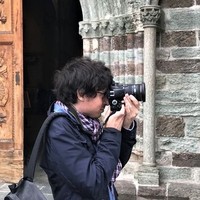- website and CV >>> lucaguerini.comedit
(with F. Colonnese) The virtual reconstruction of the perspective environment of a painting resembles the construction of a theory. It requires a number of operations that are possible only by assuming a series of hypothe- ses that are... more
(with F. Colonnese) The virtual reconstruction of the perspective environment of a painting resembles the construction of a theory. It requires a number of operations that are possible only by assuming a series of hypothe- ses that are based on an interrelated study of the work itself and its theoretical and technical presup- positions; of the artist and his or her theoretical and practical knowledge; of his or her era and of the artists and works he or she could know; and the place (as well as the client) for which the work was conceived, especially if it is a fresco for the high altar of a church. This is the case of Piero della Fran- cesca’s Madonna del Parto, of which only the central fragment remains. The work and its perspective space have been analysed here not only to evaluate their coherence with an actual architectural de- sign of the painted space but also to reconstruct the missing parts of the fresco. This was done trying to scientifically take into account all the operations performed. The reconstruction was deliberately conducted up to improbable conclusive outcomes precisely to reflect on the process rather than on the product, and on the implicit risks associated with communication in the absence of appropriate criteria capable of expressing the process itself in a transparent way.
Research Interests:
The 1518 competition organized by Leone X for the construction of the church of San Giovanni dei Fiorentini in Rome became a melting pot of ideas among the various masters who they participated. Of Raphael's project, until recently... more
The 1518 competition organized by Leone X for the construction of the church of San Giovanni dei Fiorentini in Rome became a melting pot of ideas among the various masters who they participated. Of Raphael's project, until recently considered lost, there remains only a drawing, attributed to the young pupil of Raphael’s, Giulio Romano. The goal is to retrace the genesis of the project, assimilating the logic of the designer, in such a way to solve the many gaps that are faced in the reconstruction of an unrealized project that has not arrived in its descriptive completeness. A very insightful direct observation of the document and the use of digital tools allows the development of a virtual three-dimensional model that adequately represents the project, verifying it and highlighting issues never explored and confirming the attribution to the Raphaelesque workshop led by Giulio.
Research Interests: Art History, Architecture, Vitruvius, Drawings (Architecture), 3D Reconstruction, and 15 moreItalian Renaissance Art, Classical Architecture, Renaissance Rome, Digital reconstruction (Archaeology), Italian Renaissance Architecture, History of architecture, Pantheon, Giulio Romano, Accademia di San Luca, Roma, Architettura Rinascimento, Raffaello, Architectural Thesis, Antonio Da Sangallo the Younger, Raffaello Sanzio, and San Giovanni dei Fiorentini
In the heart of Bergamo Alta, on the street called Via Porta Dipinta, stands the massive church of Sant'Andrea Apostolo. Although this church has a rich history and many works of art, the 19th-century facade is still waiting to be... more
In the heart of Bergamo Alta, on the street called Via Porta Dipinta, stands the massive church of Sant'Andrea Apostolo. Although this church has a rich history and many works of art, the 19th-century facade is still waiting to be completed. Even today, the building appears unfinished and rough-looking to passers-by; this has led the church to be unjustly neglected not only by tourists but also by many Bergamo citizens. The sad incompleteness prompted me to study its history and to reconstruct, even if only digitally, the absent facade. This study made me not only aware of the designer's intentions but also determined to virtually restore the integrity of the monument, with the imposing pronaos of the original project. The three-dimensional model also made it possible to provide the church museum with 3D printed physical models for the tactile visit of blind and visually impaired people.
Research Interests: Architecture, Drawings (Architecture), 3D Reconstruction, Classical Architecture, 3D printing, and 10 more3D Modelling (Architecture), Exhibition Design (Architecture), Lombardia, Neoclassicism, Exhibitions, Neoclassical architecture, Bergamo, Architecture Modeling, 3D-modeling in architecture, and Ferdinando Crivelli
Uno degli eventi artistici più importanti ed emozionanti della storia dell'architettura rinascimentale fu sicuramente il concorso del 1518 per la costruzione di San Giovanni dei Fiorentini in Roma, indetto da Papa Leone X. Tale... more
Uno degli eventi artistici più importanti ed emozionanti della storia dell'architettura rinascimentale fu sicuramente il concorso del 1518 per la costruzione di San Giovanni dei Fiorentini in Roma, indetto da Papa Leone X. Tale competizione divenne un crogiolo di idee ed esperienze per i diversi maestri che vi parteciparono. Del progetto di Raffaello ci rimane un solo disegno, probabilmente eseguito dal giovane allievo Giulio Romano. In questa ricerca, frutto di una tesi di laurea (relatori prof.ssa Manuela Morresi e prof. Alberto Sdegno - Università IUAV di Venezia, a.a. 2016-2017), si ripercorre la genesi del progetto, assimilando la logica del progettista, in modo tale di risolvere le numerose lacune di un progetto non giunto nella sua completezza descrittiva. L’osservazione diretta del documento, con scoperte e approfondimenti rivelatrici, insieme al disegno digitale tridimensionale, consentono di sviluppare un modello tridimensionale virtuale che lo rappresenti adeguatamente, verificandolo e mettendo in luce problematiche mai esplorate e avvalorando l’attribuzione alla bottega raffaellesca.
